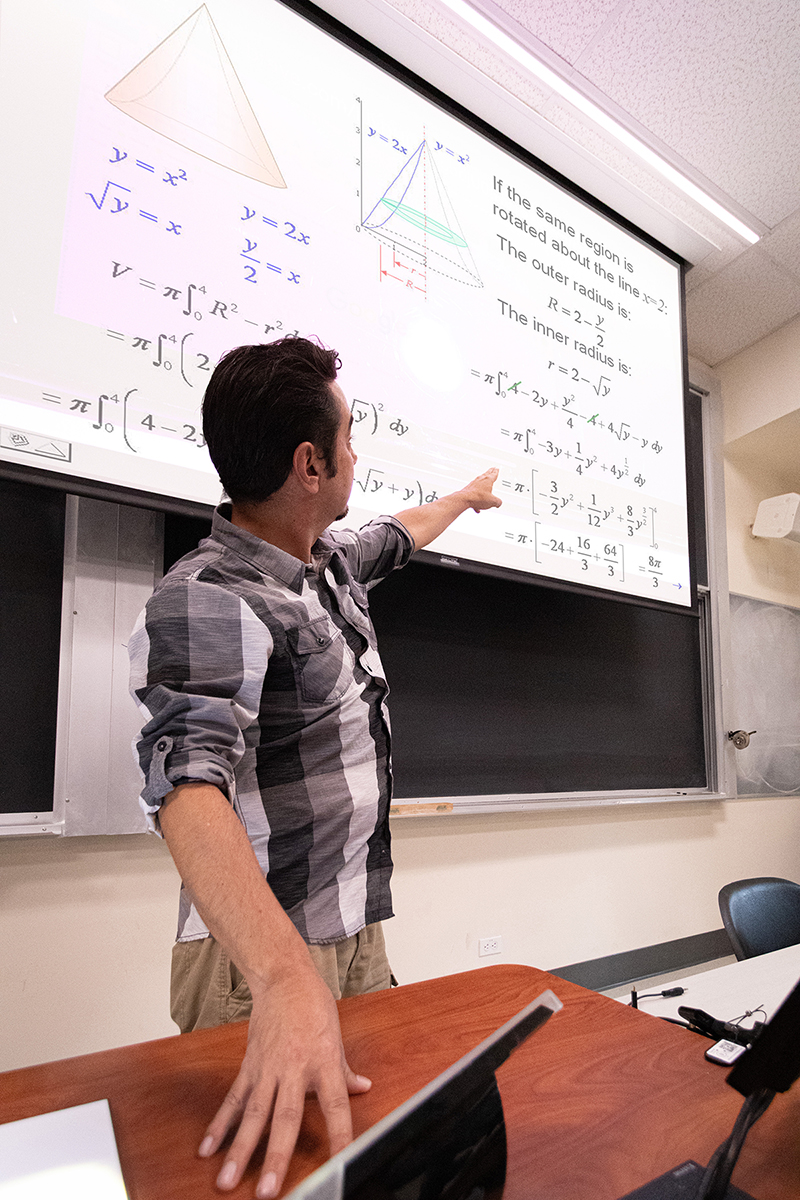
Engineering Solutions
Biomedical Engineering TEAM Lab Enhances Classroom Accessibility with Innovative 3D-Printed Device
In many classrooms, instructors use touchscreen tablets to operate overhead projectors. They are straightforward tools, but only if the user can see which buttons to press. This summer, University of California, Davis, history lecturer Seth Clark discovered his sight impairment made the tablets challenging to use.
"When I touched it, there was nothing on the tablet to indicate where the buttons were," Clark said. "It made it impossible for me to turn on the projector."
Clark quickly reached out to UC Davis Academic Technology Services' Joshua Hori to find a solution. Hori had helped him overcome other accessibility issues when he was a Ph.D. student on campus.
"The issue was with pressing the correct button," Hori said. "Because Clark couldn't see the screen and it was flat, he had difficulty identifying where to press without accidentally tapping extra buttons."
Typically, when addressing accessibility issues, it's all about removing a barrier. But in Clark's case, Hori realized a barrier — one made of plastic — was what he needed.
"I came up with the idea of a 3D-printed overlay that would go on top of the tablet with holes over the correct buttons so that Clark wouldn't accidentally tap the wrong ones," said Hori. "The problem was that I didn't have a 3D printer, and I had limited knowledge of how to create the correct design file in order to print what I needed."
Hori now had a customized design with no way to print it, soon realizing this was a unique opportunity to innovate and collaborate with the TEAM Lab in the UC Davis College of Engineering.
It Takes a TEAM Effort

Located in the Genome and Biomedical Sciences Facility, the TEAM Lab — short for Translating Engineering Advances to Medicine — features dozens of state-of-the-art 3D printers, from polyjet to fused deposition model technologies. As a service-based facility, it often creates equipment for biomedical engineers and sometimes anatomical models for surgical planning. It even played a role in UC Davis Medical Center's groundbreaking surgery to separate conjoined twins.
What many may not know is that anyone, including the public, can request its design and fabrication services, even if the project falls outside of biomedical engineering. So, when Hori contacted the lab's manager and development engineer, Steven Lucero, with his idea for the overlay, it was a welcome challenge.
The pair collaborated quickly and effectively on a design suitable for 3D printers. It took but three days for the first 3D-printed prototype and another two to finalize and install it in Clark's classroom.
The 3D-printed overlay features four holes that correspond to the exact touchscreen buttons Clark needs to use and blocks out the rest. It also includes tactile dots, from one to four, to indicate the order in which they need to be pushed, ensuring the projector is turned on correctly and ready to display the day's lesson.
"It was very satisfying to take the overlay, put it on the tablet, and have it work the first time," Lucero said. "Typically, there is a lot of finetuning that needs to be involved. It just shows that something doesn't need to be overly complicated to be effective."
Most importantly, the combined effort of Lucero and Hori addressed Clark's accessibility issue.
"It worked really well," Clark said. "As a blind professor, having the ability to independently control the tech in my classroom is always important."
Simple Device, Big Impacts
With the success of the first overlay, Hori and Lucero are already thinking of ways to improve the design and expand its use.
"We're looking at adding haptics and audio feedback to improve the experience for those who are blind or low vision, but I think this could also be really helpful to those who are maybe less tech-savvy," Hori said.
As for making the 3D-printed overlay widely available in classrooms, that's still under consideration, but Hori hopes it will become a reality soon.
Hori also believes that the TEAM Lab collaboration could be the start of larger efforts to increase accessibility on UC Davis' campus through engineering.
"[The overlay project] just goes to show there are so many things that we can do with 3D printing," he said. "We're just scratching the surface."
Learn about UC Davis policies and make requests regarding accessibility accommodations at accessibility.ucdavis.edu.
To collaborate with the UC Davis Biomedical Engineering TEAM Lab, visit their website. Rates vary based on the time and scope of each project and are offered at cost. The team plans to expand with a new, 10,000-square-foot space in Aggie Square, currently under construction across from UC Davis Health in Sacramento and slated to open in early 2025.




